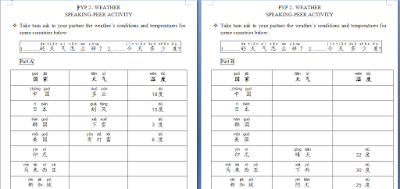Ages: 7-8 years old
Objectives:
-
Pronounce words correctly
-
Ask about and describe the weather (今天天气怎么样? 今天下雨)
-
Compose short sentences about weather (今天印尼下雨)
-
Recognize some of the characters
- Write some of the vocabulary using the correct
stroke order.
Learning
Activities:
1. Introduced a new unit and
assessed student’s prior knowledge: As a starter, I read a big book from “Mandarin
matrix” green level “天气预报”to the
whole class. This book was written in Chinese characters, which was good
because students have to use their senses (visual and listening) to know the
meaning of the story. I listed down all new words, led students to pronounce
them and asked them to tell me the meaning of each of them.
2. Passed the vocabulary sheet.
Once they learned new words orally, I directly passed the vocabulary sheet and
asked them to read the sentences and draw the weather’s symbols.
3.
Sang a weather song (Used the melody “Sedang Apa”) to review previous words and
learn new ones.
4. Showed flash cards and led them to pronounce
words correctly.
5.
Practiced Chinese characters. Chose simple characters, showed the visualization
and taught them the writing order. (下, 天,
雨, 风, 云,
晴)
6. Speaking practice. Students
learned the sentence pattern to describe a country’s weather condition. 国家
+ 昨天/今天/明天 + 天气
Note: They have
learnt name of countries in the previous unit. Re-used the old words and
combined with the new ones will help students to review and extend their
knowledge.
7. Writing practice. Each student got “raindrop”
writing template and a slip of vocabulary paper. They had to write a sentence
used that word and visualized their writing. Students were expecting to write sentence
using mix pinyin and characters.
8. Rolling activities:
ü Peer
activity; exchanged the information; there were worksheet A and B. In pairs, students
had to exchange the information to complete the task.
ü Reading
practice; read short passages and drew the weather’s symbols.
9. Taught the concept of 冷 and 热 by asking the students to draw in two posts it notes: one picture represented 冷 and one picture represented热.Then, they would practice to expand the sentence:
国家 + 昨天/今天/明天 + 天气 + 很/不
+ 冷/热
10. Summative task: students in groups created a
lap book which contains three days weather’s report in a specific country then
presented it in front of class.
















